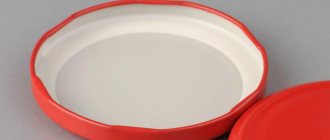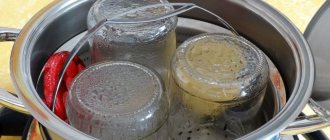Condensed milk is a popular, tasty and healthy product. It is used as an ingredient to create various sweets, or as a separate dessert. It is produced in various convenient containers (bags, tubes, jars), but condensed milk in jars is considered the most delicious. The can is usually opened with a can opener, or using a special can opener.
How to open condensed milk with a can opener? There is nothing difficult about opening a tin can. To do this, you need to do some simple steps.
How to open a tin can without an opener
Condensed milk is a popular, tasty and healthy product.
It is used as an ingredient to create various sweets, or as a separate dessert. It is produced in various convenient containers (bags, tubes, jars), but condensed milk in jars is considered the most delicious. The can is usually opened with a can opener, or using a special can opener. How to open condensed milk with a can opener? There is nothing difficult about opening a tin can. To do this, you need to do some simple steps.
- put the condensed milk on the table, press the sharp end of the opener to the top of the can and hit its handle with your hand, a hole will appear
- insert the point into the resulting hole
- hold the can with one hand and the handle of the opener with the other
- move slowly up and down in a circle
- pick up the lid with the tip of the opener and gently pull up.
You can use a simpler method and use the edge of a canned knife to make a hole in the lid, then you can simply drink the liquid or pour it directly from the hole. Just be sure to make a second hole in parallel to maintain pressure in the jar.
But it may happen that when you went to nature or to the country, you forgot to take the bottle opener with you. How to open condensed milk if the necessary device is not at hand? You can use other simple methods to open a tin container.
What to look for when choosing a bottle opener
When purchasing you need to consider:
- The material from which the can opener is made.
- Simplicity of design and ease of use.
- Compactness and weight.
To choose the most correct and successful model of a can opener, you need to determine what types of cans or bottles the device will open. And also how often it will be used.
If you need a small and universal model that can be used to open iron cans, cans or bottles and used occasionally, then a manual opener would be the best choice. When choosing, you need to pay attention to quality. A good material for manufacturing would be stainless steel. The handle should be made of wood, plastic or rubber and firmly fixed. There should be no defects or roughness on it.
If you need an opener that can quickly and effortlessly open several cans, then a mechanical device will be the best choice. It is the most convenient and less dangerous. But when purchasing a mechanical opener, you must remember that you will need a separate device to open bottles.
When choosing an automatic device, the quality of the tool is important. The best models are made with a body made of metal or high-strength plastic. Automatic openers are convenient, reliable and durable. But we must remember about timely replacement of nutrients. When taking the device with you on a hike or to the country, you need to purchase an additional set of batteries.
Electric models are very convenient for frequent use. But they are not cheap, so before purchasing you need to carefully read the instructions and the warranty period.
Precautions when opening canned food using improvised means
In fact, you can use any hard, sharp object to open canned food (as long as it is made of a material harder than a metal can).
In addition to the methods listed, many people use other, more non-standard instructions:
| Item used | The essence of the method | Advantages | Flaws |
| a cobblestone with a rough surface or a piece of concrete | acts similar to sandpaper in creating friction | the edges of the open lid are not sharp and less dangerous | requires long, consistent effort |
| pocket knife and stone | Use the tip of a knife to punch a hole in the edge of the lid, then knock it out with a heavy stone (after depressurization) | can be used outdoors or in unusual conditions | there is a high probability of contaminating food with small pieces of stone or other foreign particles |
| fork | You need to position the fork so that one of the tines is on the inside edge of the lid and press down firmly to pierce it, then repeat this step along the edge in a circle, punching holes. | a useful method in the absence of other tools | The plug may break and become stuck in the lid, making it even more difficult to open the jar. |
| pliers | you need to hook the side edge of the lid and turn until a hole appears | the lid can be damaged quite quickly | Fragments of metal shavings often end up in food |
Opening cans using improvised means is nothing new, as the can opener was invented more than 50 years after the first sealed tin food cans were introduced. Moreover, some methods have a long history and are considered very reliable. Therefore, it is recommended to resort to the most practical and safe proven methods, and only in extreme cases, open cans with bare hands or with traumatic objects.
Other precautions may include the following:
- Do not try to saw off the lid with a bread knife. As a result, metal shavings will remain in the contents of the jar.
- Any method that does not involve the use of a special opener may result in metal shards or dirt particles getting into the food. Therefore, it is necessary to exercise caution and inspect the product carefully before use, in good lighting.
- Food from cans that have burst or been punctured for 1 day or more should not be eaten, since there is a high probability that dangerous bacteria have multiplied in them.
- None of the methods for opening canned food with improvised objects is ideal, and each of them carries a risk of injury. Therefore they should not be used by children. You should take proper precautions and take your time when trying to open a jar without a can opener.
With a knife
The most popular way to open a can of condensed milk without an opener is using a regular knife. Many men always carry a penknife with them, which can help out in such a situation. With a little physical strength and a couple of simple steps, you can easily open the required tin container.
- To prevent the can from jumping to the side and injuring you, you need to tightly clasp it with your hand
- holding the handle of the knife with your hand, place its tip against the edge of the can itself so that it is vertical to its surface
- press hard on the handle of the knife, after which part of the blade will end up in the jar itself
- move the knife blade slowly up and down along the diameter of the tin, while cutting its surface
- use the tip of a knife to pick up the cut edge of the container and boldly lift the lid up
Mechanical keys
More complex mechanical designs are often used in catering establishments. A professional can opener is fixed to the edge of the table using screws or special clamps.
Homemade machines consist of two levers and a thumb, which, when turned, cuts off the lid of the can.
Advantages of a mechanical opener:
- High quality sharp blades, sharpened on both sides, made of hardened carbon steel.
- Rust-resistant mechanism.
- Plastic bushing that facilitates movement and reduces physical effort.
- Simplicity of design, allowing you to independently disassemble and reassemble the mechanism if necessary.
- Dishwasher safe.
Pocket knife
The packaging is made from a thin sheet of tin that can be easily cut with a regular knife. In this case, you will need very little effort, and the contents of the jar will remain intact. To do this you should:
- Place the jar on a flat surface and place the tip of the knife over the inner rim of the lid.
- It is necessary to hold the knife strictly in a vertical position and in no case at an angle. To avoid injury, you should hold the handle firmly.
- Next, lightly tap the handle of the device with the fist of your free hand. This will allow the tip of the knife to pass through the metal. The blow should not be too powerful so that the tool does not jump out of your hands.
- Then you need to move the tip a few centimeters along the edge and make another hole. So you need to go along the entire border of the lid.
- Next, the tip of the knife is passed through one of the recesses and the lid is carefully bent upward.
Since the edges of the metal are sharp, it is better to protect your hands with a towel when bending the lid.
Using your hands
There is a situation when you don’t even have improvised tools at hand, how to open condensed milk without a bottle opener? If a person is physically strong, then this will not be difficult.
- Hold the jar horizontally with the palms of both hands and make a dent in the middle on the sides with your fingers, repeat this movement several times in a circle
- Grab both bottoms of the jar with your hands and make counter movements, squeezing the container until the bends crack, then it can be opened in half.
Bare hands
There are times when there are no objects nearby at all. In this situation, you have to rely only on your own hands. The method will only work for a strong and physically fit person:
- Hold the jar between your palms. In this case, it should be located horizontally. Make a dent in the center of the side with your fingers. Then you need to press again on the resulting depression so that the metal bends inward even more.
- The same steps must be repeated on the other side.
- Now you should take both bottoms with your palms and make uniform rotational movements towards each other. The deflection area should crack. The jar can be divided into two halves.
The bare-hand method is suitable if there is not a large amount of brine or oil inside the jar.
With the help of a stone
What to do if you find yourself far from civilization and there is no knife, and no strong male hand either? Then be smart and try to open the condensed milk using stone or concrete. The technical process of production sealing of cans at the enterprise consists of bending the edges of the lid using a powerful press around the cylinder of its base. If you try to remove the top layer of metal that protrudes, then the tin container will open with ease. To do this, you need to perform a simple operation.
- place the bottom of the jar on your palm
- Press the jar with the lid down onto the stone or concrete and make movements in a circle
- After a couple of minutes, the edges of the side will be erased; lightly press on the sides of the lid and it will open easily.
How to easily open a tin can with an opener
The classic way to open is to use a can opener, which consists of a working part and a handle. The working part at the end contains a stop in the form of a loop and two wedges: the large one can open canned food, the smaller one can open the lids of glass containers or bottles.
Many canned foods can be opened without a can opener.
The handle can be plastic, wood or metal. This is an old, time-tested method. A plus is the reliability and simplicity of the opener. But revealing something to her is not always too easy.
Important! You need to make an effort to make the first hole, and it’s not always possible to open the jar carefully. Using a hammer and knife, you can easily make a hole. But if there is no tool, only experience and physical strength will help. In this case, only a physically developed man can handle it with ease.
The main thing is not to explode =)
To be honest, until I started the process, I was so brave that I didn’t see any problem. And the picture was clearly etched in my memory of how deftly and simply my mother did it. But this is in general terms, but I absolutely don’t remember details such as: did mom take off the label? did you wash the jar? how much water did you pour into the saucepan? What fat content do you need for condensed milk, or will any kind work? I don’t even remember, but did it ever happen that my mother’s jar exploded, and what did she do? But that’s what the experiment is for, to find out all this and share experience.
Using a tablespoon
If you don’t have an opener at home, but you urgently need to open a can of condensed milk, what should you do? You can, of course, go to your neighbors, or you can use a simple method to open a tin container using a regular spoon. The process itself is a bit complicated and will take a lot of time.
- put condensed milk on the table, grab it tightly with one hand, and take a spoon with the other
- in the place where the jar is in close contact with the side of the lid, rub diligently with the edge of a spoon along the entire perimeter
- Press firmly with the fingers of both hands on the hole formed and, poking it with a spoon, remove the lid.
Such simple methods as opening condensed milk without improvised devices will help solve the problem in the most force majeure situations. The most important thing is to open these options very carefully, as you can get hurt by the tin and make sure that no dust or dirt gets into the liquid. Of course, the best thing to do when going on a picnic is to take with you the necessary kitchen items so that you don’t have to resort to similar methods.
Electric cars
Capable of opening any number of cans as quickly as possible. The electric opener consists of:
- A holder that securely fixes the can, preventing accidental falling, slipping and injury.
- The motor that starts the mechanism.
- A knife mechanism that quickly and without the use of physical effort opens the lid.
Portable and stationary electric models are widely available. Portable ones operate with batteries; you can take them with you on hiking trips, fishing, or to the country house. Desktop accessories operate on mains power only.
Multifunctional types of openers with various additional accessories, wall-mounted and table-top, are also produced.
How to open a glass jar
Usually a glass jar is sealed with a simple or screw-on lid. Simple lids are used at home when canning vegetables. In production, containers are closed with screw caps. How to open a rolled up can:
- Home canning. When opening a twisted jar of cucumbers, all the work is done with a knife, being careful not to cut yourself. We draw a tick on the lid of the container so that its three sides reach the very edge of the lid. The lid is cut exactly along the lines, after sticking a knife into it. The entire cut section is slowly twisted onto the knife. Then the remaining part is removed.
- Industrial conservation. Opening a jar with an iron lid is twice as fast as opening a canned jar at home. It is enough for air to get inside the container. To do this, pry off the lid with a knife. When there is a barely audible pop, it is open. You can replace the knife with a rubber mallet. They hit the lid with it to make a bang.
Cooking process
Place a saucepan with a can of condensed milk on the fire. Turn up the heat and wait for the water to boil. All this time the pan is covered with a lid. This creates the necessary conditions for preparing the product. The water began to boil. Without removing the pan from the heat or removing the lid, simply reduce the heat. Let's make it very small. The process of simmering the product has begun. From this moment on, the cooking time for condensed milk is measured. So, my jar, weighing 380g and with a milk fat content of 8.5%, was cooked for 3.5 hours. This is the ideal time to prepare it.
Advice! Condensed milk takes a long time to cook and you can easily forget about it. Just get carried away with cleaning and miss the time when it will be the consistency we need. We get out of the situation using an alarm clock or timer on the phone.
Time has passed, the condensed milk is ready, you can safely turn off the heat. But don’t rush to remove the jar from the hot water. Let's let them cool together. This way the milk still “arrives.” And after 1.5-2 hours, you can safely remove and free the jar from the plastic bag. Boiled condensed milk is ready!
Video
Nourishing, tasty, just melts in your mouth! It contains all childhood dreams! But not only kids are in love with this product, we all easily turn into pooh-poohs when it comes to... condensed milk. It is used to lubricate cake layers for your favorite waffle cake, which more than once saves any housewife when guests are on the doorstep or when you want to pamper your family.
This product is used in creams or as a filling for cakes and dried fruits, for homemade sweets. Condensed milk is such a popular product in making desserts that it is worth paying attention to it. Or rather, we will talk about how to cook condensed milk in a jar at home. Let's break some housewives' spell of fear before cooking condensed milk. For the purity of the experiment, everything I say will be done right there, before your eyes.
Getting ready to cook condensed milk
There is a traditional sticker on the can, we don’t need it. Yes, and it will peel off on its own and it will not be entirely pleasant to watch how it colors the water and what it turns into. We remove it and wash the jar or wipe it with a damp cloth to remove dust.
But here is a secret that I got from my mother. She complained more than once that the glue that held the sticker could not be washed off with any water, but during the cooking process it melts and settles on the walls of the pan. What to do? It's simple! We put a clean plastic bag on the jar, and the pan is protected!
And here, girls, pay attention! It is worth taking a large, or better yet, deep saucepan. The main rule for cooking condensed milk is that water should ALWAYS cover the jar. Therefore, in order to calmly do other things all this time, and not stand over the pan and constantly add water to it, you need a spacious container.
Use of special means
In order to make opening metal cans easier, people have come up with many special devices.
Manual
Many people know how to open a can with a can opener, but not everyone knows how to perform this action correctly. There are different types of knives, but each of them consists of a holder and a sharp metal element that is used to cut the lid.
This is the easiest and most affordable way to remove canned food, although the opening process varies depending on the opener model.
The most common opener consists of a wooden handle and a built-in tool for cutting metal. Actions with it are simple:
- place the jar on a flat, hard surface;
- the knife is installed in a vertical position with its tip at the edge of the rim;
- sharp pressure on the handle forces the cutting part to pierce the lid;
- with forward movements, following the diameter of the lid, prying the lid off, cutting it to the end.
Attention! Before you open a metal can with a regular can opener, you need to hold it firmly.
There are more modern openers with a plastic handle and wheel. Typically the process is performed in the following sequence:
- a wheel with teeth is installed on the inner rim;
- squeeze the handles tightly until the wheel pierces the lid of the iron can;
- continuing to hold the handle with one hand, turn the lever with the other hand so that the wheel running along the inner rim of the can cuts the metal as it rotates;
- When the wheel has passed around the circle, the can is considered open. Before removing the canned food, take a fork and remove the stained lid.
Important! Care should be taken to ensure that the jagged protrusion of metal above the blade aligns with the sharp edges of the raised rim of the can when opening.
There are several modifications of manual devices for opening canned foods. You can watch videos on the Internet to learn how to use a can opener.
You might be interested in reading the article “Opening a Can without an Opener.” Read here...
Mechanical
Externally, such mechanisms are more cumbersome. If you often need to open canned food, such a reliable device can be used in the household. But more often they are used in catering establishments. Before opening canned food with a mechanical opener, the structure is fixed tightly on the table. The operating principle is not complicated:
- the can is secured in a special holder;
- The top of the lid is broken with the sharp end of a sharp blade;
- the movement of the knife opening the can occurs due to the rotation of a special valve.
Automatic
The model runs on batteries and is easy to use. The mechanism is installed on the lid and the switch button is pressed. The positive qualities of such a device are obvious:
- no physical effort required;
- the edges of the cuts remain smooth;
- takes up little space when stored;
- lasts a long time.
Important! The device should not be allowed to fall into the hands of children.
Electric
At home, you can use an electrical appliance. Outwardly, it resembles a manual mechanism. But such a device can open a can of canned food in a matter of seconds. To do this, fix the can tightly, install the mechanism with a wheel on the inner rim of the can and press the button. The motor located inside drives the impeller. Before using such a tool for the first time, it is important to find the user manual and carefully read about how you can correctly open any can with an electric opener.
Advice! When opening a can in this way, you should hold it firmly so that the contents do not spill on the floor.
(2 ratings, average 4.5 out of 5)
What is useful to know for those who want to learn how to cook condensed milk
It's time to take stock. Secrets, subtleties, nuances, alternatives!
Choose quality condensed milk
Not every condensed milk is recommended to be boiled; some will not work at all. If it contains ingredients such as milk powder, flavoring additives, vegetable fats, etc., then it is not a fact that you will be able to prepare condensed milk; it simply will not thicken. Only experimentally can such milk be tested for suitability for preparing a boiled product.
Density is determined by the composition, fat content, jar volume and cooking time.
After I cooked several cans of condensed milk, I accidentally made a discovery for myself! The density of the resulting product depends directly on several factors: composition, fat content of condensed milk, volume of the can, boiling intensity and cooking time. So, the longer the milk is boiled, the thicker it turns out (of course, we are not talking about 5-6 hours, because cooking too long can also in rare cases lead to an unwanted explosion, and to check whether we are included in this number, oh, no matter how you want it).
The condensed milk in the jar should be completely covered with water
Let me remind you again! It is important! Water should be poured in advance a few centimeters above the can of condensed milk. Otherwise, if it boils away, this is a direct path to the Great Explosion in your apartment, but I’m afraid that you won’t be able to create a new way to create life, but it will help you get to know the Emergency Doctor and the person on duty at the emergency room. I don't think that's our goal right now. So let's be careful!
Cook over low heat
Do not think that the process of simmering condensed milk over low heat can be replaced by quick cooking if the fire is made larger. It's better not to get down to business if you don't have these 3-4 hours. Or put it away from the fire if urgent matters arise. Yes, this time you won’t get the desired result, but there won’t be an explosion either.
It’s interesting that many people are afraid to buy condensed milk for cooking in cans that open with a ring. But I can confidently recommend them for use. In any case, for me they behaved the same way as those that were completely sealed.
Cool the jar of condensed milk slowly
When cooling the condensed milk, take your time. Don't open the jar right away; I don't recommend adding cold water to cool it down. I definitely understood that cooling is part of the cooking process, and should happen gradually.
You can cook it in different ways, but with caution
You can cook condensed milk not only in water on the stove. There are more original and fresh recipes. For example, in the microwave, oven or in a pressure cooker and multicooker. And recently I heard about a new recipe: in a frying pan! But I haven’t tried one of them yet, but it’s interesting! Girls! I will always be glad to hear your opinion, advice and recommendations on how to cook condensed milk in a jar at home. Your experience and what secrets you have are interesting. Share them! But not only your positive experience is interesting, but also stories that are lethal for condensed milk. Let's work on the mistakes together to uncover the golden recipe for cooking condensed milk.











